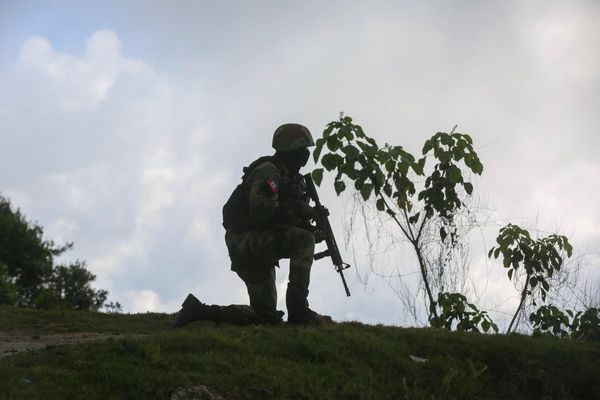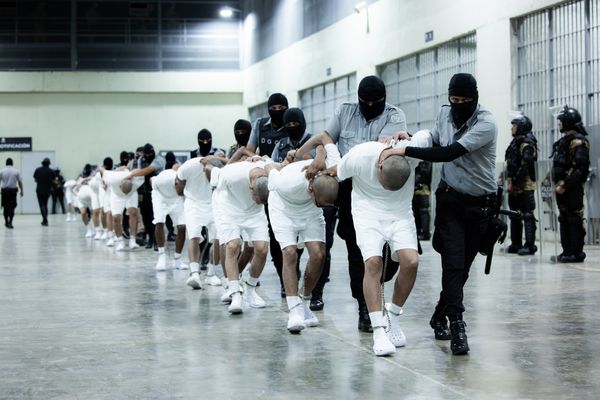
Russia’s attack across the border north and north-west of Kharkiv was telegraphed by Moscow, predicted by western intelligence and anticipated by Ukraine. The fact that Russian forces have been able to advance about 4 miles at multiple points in five days raises serious questions about Kyiv’s ability to defend itself.
An intention to create “a sanitary zone” along the border inside Ukraine was signalled by Vladimir Putin in March. A month later Sergei Lavrov, the foreign minister, highlighted that Kharkiv had an “important role” in such a strategy as the region was reeling from bombing that had knocked out two power stations on 22 March.
At the same time, Moscow’s military had been building up its new Northern Group of forces, estimated by the Institute for the Study of War (ISW) at 30,000 strong, in Russia’s Belgorod region. Last week, two days before the dawn assault, Kharkiv’s regional governor said a massing of forces had been spotted.
A warning was also passed, one source added, from UK defence intelligence to Ukraine’s leadership. So when on 5am last Friday, somewhere between 5,000 and 10,000 Russian soldiers crossed the border at two key points, it might have been expected that the attack would be swiftly repulsed.
In fact, Ukraine’s defensive lines were thin to absent. At Vovchansk, less than 40 miles north-west of Kharkiv, “the first line of fortifications and mines just didn’t exist”, wrote Ukrainian commander Denys Yaroslavsky on Sunday, while a Ukrainian veteran with contacts in region said “units were simply not prepared to fight” and defences “not properly positioned”.
By the middle of the week fighting had reached Vovchansk and villages north of Lyptsi, about 20 miles away from Ukraine’s second city, home to 1.3 million people. A near-term goal would be for the invaders to reach the range of Russian 152mm artillery, about 15 miles, from which it would be possible to resume shelling of parts of the city, last in gun range in September 2022.
The rapid reversal in an area previously considered quiet is the latest setback for Ukraine in 2024. So far this year Russia has continued to increase the size of its invasion force, to 510,000, and exploited the defenders’ air defence and munitions shortages to capture Avdiivka in February and seize a bridgehead north west of it in April. In May it began to menace Kharkiv region with the hope of frightening the population to move.
Since March, as identified by Maria Avdeeva, a Ukrainian security expert, Russia has been engaged in a steady stream of online propaganda aimed at unsettling Kharkiv city and region residents. Postings from pro-Russian Telegram channels told residents of Kharkiv oblast (and neighbouring Sumy) in April “to prepare for combat operations in the built-up areas” and messages circulated of fake evacuation plans encouraging city residents to flee west and south.
Ukraine’s military difficulties have been caused in part by the four-month pause in weapon supplies from the US – finally resolved last month when a $61bn aid package passed Congress – and European countries’ struggle to ramp up arms manufacturing before late 2024. At the same time, Ukraine, outnumbered on the battlefield, is struggling to conscript men, and has reduced the minimum age from 27 to 25.
Shortfalls in Ukrainian artillery and an absence of defences against ballistic missiles and long-range glide bombs have been well observed in recent weeks. But Jack Watling, a land warfare expert at the Royal United Services Institute thinktank, said Russia was also overcoming the limitations of its undertrained army and beginning “to compound its advantages” with munitions.
Such is the diminishment of Ukraine’s frontline surface-to-air missile defences, that they are focused on deterring Russian jets from crossing the frontlines. But they are no longer able to knock out Orlan-10 reconnaissance drones, which are now “routinely flying over both Kharkiv and Zaporizhzhia”, Watling said in a new paper and more “accurately detect and destroy targets behind the frontlines”.
Russia has been bombing Kharkiv city since the end of March with air-launched glide bombs. In the latest attack on Tuesday, the Kharkiv oblast governor, Oleh Syniehubov, said four people were injured after bombs struck the north of the city. Later the same day, the president, Volodymyr Zelenskiy, anxiously asked Antony Blinken, the US secretary of state, for two $1bn Patriot air defence batteries to help defend the Kharkiv region.
Military analysts stress there are explanations for why Ukraine has been forced back. The area occupied is lightly populated grey zone that was especially hard to defend because Ukraine is banned from using US weapons to strike targets in Russia itself.
“It’s suicidal for Ukraine to have its main line of defence on the border, where the Russians can hit you with artillery and glide bombs and the Ukrainians don’t have weapons available like Himars rocket artillery to hit back because of US restrictions,” said George Barros, an analyst with the ISW. As a result, Russian forces can mass across the border in a relatively safe space.
The analyst argued that Ukraine “has to defend a tremendous amount of territory, but is struggling with manpower issues” – meaning they do not have the capability to create Russian style fortifications along the entire northern frontier. In the aftermath of the Kharkiv incursion, Brig Gen Oleksandr Yakovets emphasised that better fortifications were prepared in the second line, “15-17km from the frontline” and in the third up to 35km deep.
So far, the forces that Russia has committed to Kharkiv, up to 30,000 from Belgorod, rising to 50,000 if nearby forces are included, are nowhere near enough to threaten a city the size of Kharkiv, Barros said.
The battle is not a territorial struggle for Ukraine’s second city, but more likely a combination of a diversionary attack to weaken defensive lines in the Donbas and an attempt to use bombardment to turn Kharkiv into a ghost town.







